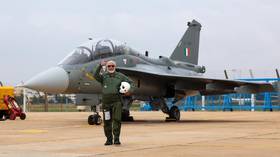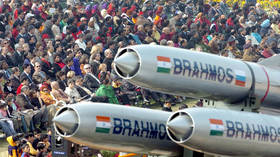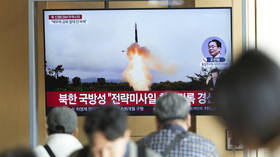Sword of Bharat: How India aims to conquer the global arms market

On Saturday, Tejas, India’s domestically built light combat aircraft (LCA), received the biggest endorsement in its short history when Prime Minister Narendra Modi undertook a sortie in it.
It surely would not have been easy for the 73-year-old VIP passenger to withstand the 2G force as the LCA took wing.
Soon after landing, Modi took to social media and tweeted, “A flight to remember! Tejas is India’s pride, a manifestation of the strength and skills of 140 crore Indians.”
Modi’s daring effort may well be a shot in the arm for Tejas, which just wound up an impressive showing at the biennial Dubai Airshow. Together with BrahMos, touted as the first supersonic cruise missile in service and showcased at the Dubai Airshow, they make for India’s new calling card in the lucrative but complex business of defense exports.
The theme of this year’s airshow in Dubai was the ‘Future of the Aerospace Industry’ and involved more than 95 countries.
India believes that having successfully produced defense products indigenously that can hold their own internationally, it has what it takes to enter into defense exports. And, hence Dubai, like other international defense shows, was an obvious destination.
According to Indian officials, the two marquee exhibitions – especially the sorties that Tejas carried out during the show – drew buyer interest, though no deal was inked.
The Tejas way
It is a an established fact that the existing fleet of aircraft with the Indian Air Force (IAF) are rapidly ageing and need immediate replacement. Import dependency to bridge this deficit is strategically risky, especially when regional wars are spreading across the world.
Tejas, produced by the state-owned Hindustan Aeronautics Limited (HAL), was part of the solution. Though Tejas made its maiden flight in 2001 and limited production of the aircraft commenced in 2007, its progress was laboured. Billed as the world’s smallest and lightest supersonic fighter jet, it was inducted into the IAF only in 2016. That was thanks to a nudge from former defense minister Manohar Parrikar to overcome resistance both from within the government and the IAF.
The production plan for Tejas drew inspiration from the very successful playbook pioneered by the Indian Space Research Organization (ISRO). It entails growing an ecosystem of vendors to produce components – this has recently evolved and now allows private players to produce final products like satellites.
This playbook has ensured a national footprint for the production of Tejas. The central fuselage of the plane is produced by VEM Technologies, Hyderabad, the fin and rudder by Tata Advanced Systems (TASL) in Bangalore, rear fuselage by Alpha Tocol, Bangalore, wing by Larsen&Toubro, Coimbatore, and front fuselage by Dynamatic Technologies Limited (DTL), Bangalore.
Indeed, the vendors are concentrated in the south and west of India. There is an outlier though in Uttar Pradesh – the traditional laggard in India’s development story – which in recent years has pitched and grabbed defense-related investments.
A HAL spokesperson at the Dubai Airshow explained the logic of the decentralized production strategy.
“The development of a complex supersonic aircraft like the LCA Tejas is a testament to the collaborative efforts and capabilities of India's defense manufacturing ecosystem. It involves the cooperation of various agencies, organizations, and institutions across the country. More than 400 Indian business partners are involved in the development of the LCA Tejas.”
What this is doing is creating an organic domestic production structure. Consequently, in future, it will be easier to cater to other ambitious programs – including the production of Advanced Medium Combat Aircraft (AMCA), a fifth-generation stealth, multirole combat aircraft.
The BrahMos hypersonic missile story is different. It is a joint venture, BrahMos Aerospace, inked with Russia in 1998. Russia’s rocket design bureau, NPO Mashinostroyenia, supplied the supersonic propulsion, while the Defence Research and Development Organisation (DRDO), the R&D wing of the government of India, developed the guidance and navigation systems and the command and control elements.
The first successful launch of BrahMos took place in 2001 and soon it was doing the rounds of international exhibitions. The missile is now part of the arsenal of the Indian Army, Navy and Air Force. Unlike the Tejas, it has an export order in the bag – the $375 million deal it clinched with the Philippines last year. The deliveries are scheduled for early next year.
At the Dubai Airshow, the company was also pitching for its mobile autonomous launcher and the BrahMos NG (next generation), a lighter and more versatile missile that will be ready for rollout in mid-2025.
“We will start the trials in the end of 2024,” said Praveen Pathak, director (market promotion and export) of BrahMos, on the sidelines of the airshow.
“We have seen a lot of interest from countries in the Middle East, the Philippines and Indonesia. We are hopeful the discussions with the UAE and other governments concludes favourably,” Pathak added.
Once again, the production process involves private-sector companies.
Home advantage
The big upside of indigenization is that it ensures strategic advantage or at the least de-risks by reducing dependence on a foreign supplier. At the same time, it also provides an opportunity to create defense clusters across the country and provide economic opportunities for defense start-ups.
According to the federal government, around 100 Indian firms are engaged in defense exports to 85 countries. An official release claims that India’s defense exports grew 23-fold from 6.8 billion rupees in 2013-14 to nearly 160 billion ($1.92 billion) in 2022-23.
For context, defense exports by the United States aggregated a staggering $51.90 billion.
This capability to indigenously manufacture weaponry has also reduced the country’s dependency on defense-related imports. Their share dropped from 46% of overall expenditure in 2018-19 to 36.7% in December 2022.
Where India Meets Russia – We are now on WhatsApp! Follow and share RT India in English and in Hindi
The statements, views and opinions expressed in this column are solely those of the author and do not necessarily represent those of RT.














